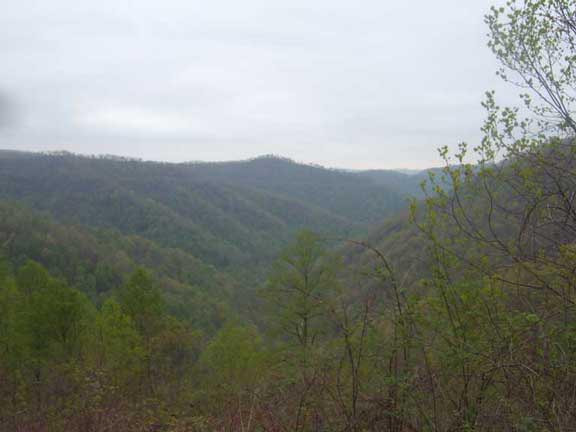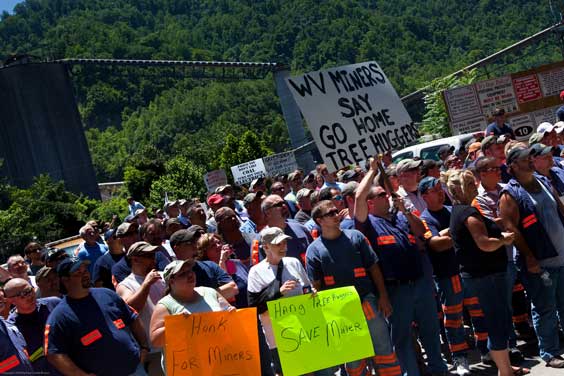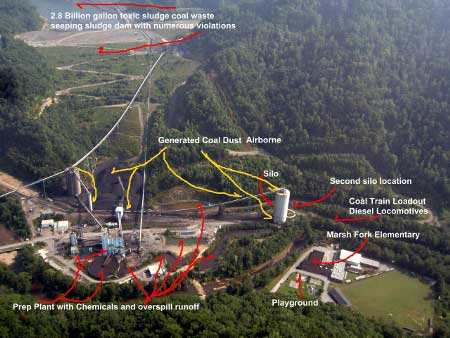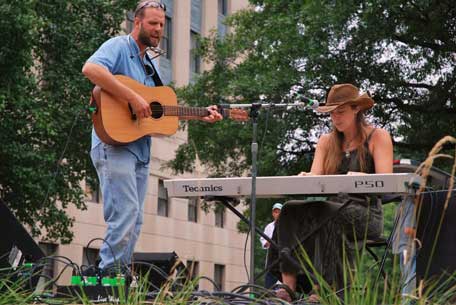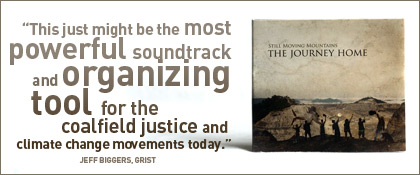Coal River Journal
By Jen Osha(Photo at top by Matt Noerpel)
When I first came to the Coal River Valley of West Virginia, I was wearing my uncle’s favorite boots. Rugged, yet well cared for, they served me well stomping about on the rocky moonscape of the strip mines. He was always a practical man.
He also sent me to West Virginia with his blessing. My uncle Tim was a retired mechanic from the surface coal mines in southern Indiana, and a union organizer during the strike against Peabody coal. Proud of his community and his work, he took me on a tour to show off the reclamation areas where my cousins could swim and play beneath healthy hardwood trees. He explained to me about how the topsoil had been hauled back into mounds, to be returned to its place once the coal was extracted and the land was reclaimed.
Indiana is mostly flat, though, and he had heard that surface mining was “done differently” in the mountain states. Instead of returning the topsoil to the surface, non-union outfits pushed the soil and rock into valleys and filled them up. I remember him slamming his hand on the steering wheel as he asked me these questions: how was it legal for the topsoil to be pushed into a valley instead of replaced on the surface as part of reclamation? why were so many of these mountaintop removal mines non union? Why were coalfield communities not resisting now like they did during the mine wars?
Nine years ago, I came to West Virginia with a forestry degree and a head full of questions and good intentions. I walked the soles off those boots, and my uncle has passed on, but those questions still motivate me. What I thought would be a summer trip evolved into a life long commitment to the hills and hollows of West Virginia, in which my son is now rooted. “I work for the mountains!” he piped up, when asked to introduce himself to his kindergarden class. And then, when I picked him up after school: “Did they stop blowing up the mountains today, mom?”
No. In fact, 3,000,000 pounds of explosives are used against West Virginia mountains every working day…and not just against the mountains, against the people who live in the hollows underneath these sites as well. And the trees, the rich layer of topsoil, and everything else in the way of the coal seams is pushed into adjacent hollows to create valley fills. The late Bill Maxey, the highly respected director of the West Virginia Division of Forestry, retired in protest against mountain top removal: “All native plant and animals are practically eliminated....makes the landscape so unsightly that it ruins tourism....actually destroys more coal mining jobs than it creates....is analogous to serious disease, like AIDS..."
Yet to believe the news about and the rhetoric surrounding mountaintop removal, it is only outside environmental agitators that see any problem with mountaintop removal. Even local residents who stand up to protect their homes and families are termed “tree-huggers” and judged in opposition to the hard-working coal miners just trying to put food on their table. The fact that many of those resisting mountaintop removal are hard-working coal miners themselves, or come from families with a strong union background, is largely ignored. A quick look at the handwritten signs from recent protests, from the funny (Hug a miner, you’ll never go back to trees) to the dangerous (Save miners, hang treehuggers) show this paradox. It is a hard thing indeed to answer my uncle’s questions when there’s no room in the argument for local residents and miners who don’t want their homes and culture destroyed.
Pro mountaintop removal miners in front of the Goal's Coal Processing Plant with signs claiming to represent all miners. A clear shot of the signs showing how many view the debate as tree-hugger versus miners, despite the many mining families who want mountaintop removal to end. Photo (C) 2009 Paul Corbit Brown, www.paulcorbitbrown.com
Protest at Marsh Fork Elementary, 29 arrestedNo where was this opposition more directly apparent than at the June 23rd protest at Marshfork elementary school, where “miners” held the bridge against “treehuggers” who were engaged in non violent civil disobedience to raise awareness about the very real dangers of mountaintop removal. The safety of the 230 children at Marshfork elementary school is a focal point of the resistance against mountaintop removal as well as the slurry impoundments created through the process of cleaning coal. The school is only 225 feet from the coal silo at Goal’s Coal Prep plant and beneath a 375-foot tall earthen dam, only 400 yards away, that holds 2.8 billion gallons of toxic waste. If this dam broke, a wave of sludge more than 24 feet high would hit the school and downstream communities, killing more than 900 people. If that wasn’t enough, the school sits below a 1,849-acre mountaintop removal site.
Marsh Fork Elementary, the Goals Coal Processing Plant and the Edwight surface mine (operated by Independence Coal and Alex Energy) (Photo by Bo Webb)As a mother, I am particularly receptive to concerns from parents about the safety of their children. Debbie Jarrell’s granddaughter used to attend Marshfork Elementary and told me of her fears: “You’d have to worry about whether you should send her to school the next day if it rained a little bit, or if it was raining while she was at school if you should go and get her. No grandparent, or no child, should have to be forced with the decision of whether they can go to school because it rains or not, or whether or not they’re going to be safe while they are at school. They should be guaranteed that they are safe at school, especially from something like that.” Over and over I heard these stories of concern and fear from flooding and from a slurry impoundment failing. What truly left me sleepless, however, was learning the different ways that children living under these massive dams and denuded mountains reacted to a heavy rain: go to sleep in your clothes, with your favorite toys packed, and with a flashlight close at hand. A certain childlike practicality to the reality that their parents are going to be up watching the water level all night, and they might have to run without having time to pack. I was inspired to write "Shumate Dam" as a testimony to the bravery of the children and their families who live day to day under these threatening circumstances, as well as out of righteous indignation that any parent should have to put their children to bed in fear as a sacrifice to our nation’s energy needs.
Sing for the children in their mountain homes
Who hear rain on the roof and go to sleep in their clothes
While their parents watch the water cause nobody knows
If tonight is the night the slurry dam will blow
If tonight is the night the slurry dam will blow
Grayson Samples and Jen Osha performing 'Shumate Dam' at the August 23rd release concert for Still Moving Mountains: The Journey Home, on the Capital grounds, Charleston, WV (Photo by Brian HarrimanClick here to listen to Jen Osha perform 'Shumate Dam'
In this journal, I am honored to share stories about the bravery of the residents and volunteers who have come from across the nation to stand together against the injustices of mountaintop removal. Welcome to the Coal River Valley, where there is a strong movement growing against mountaintop removal and increasingly, finally, local voices of resistance being heard. The direct action movement in the Coal River Valley (Red Alert in Appalachia), in which 105 people have been arrested so far in acts of civil disobedience, is growing from the ideas and support of many local families who feel that their lives, their jobs, their health, and their culture are mere externalities in the quest for cheap energy. For the last 16 months I have listened and learned from the long time residents of the Coal River Valley who are willing to speak out against mountaintop removal. I have heard and shared the music and stories of local residents, many of whom have lived and mined coal in the Coal River Valley for generations, who want mountaintop removal to stop. Their forms of resistance differ; some don’t want their names to be used but share their stories, others will stand on a stage in front of screaming neighbors and speak their piece. Coal may keep the lights on for now, but their voices show the human cost. And yes, there are men and women who provide for their families by working on mountaintop removal jobs, but at the cost of their neighbors’ homes, land, health, clean water and peace of mind.
Jen Osha is the Director and Founder of Aurora Lights, a West Virginia-based non-profit that is currently working to raise awareness about the social and environmental impacts of mountaintop removal in Appalachia. Please visit auroralights.org to learn more about the movement, purchase the benefit CD, Still Moving Mountains, or access educational multimedia resources about the Coal River Valley.
Questions and/or comments for Jen Osha? Write her at: jenosha@auroralights.org
Founder/Publisher/Editor: David McGee
Contributing Editors: Billy Altman, Laura Fissinger, Christopher Hill, Derk Richardson
Logo Design: John Mendelsohn (www.johnmendelsohn.com)
Website Design: Kieran McGee (www.kieranmcgee.com)
Staff Photographers: Audrey Harrod (Louisville, KY; www.flickr.com/audreyharrod), Alicia Zappier (New York)
E-mail: thebluegrassspecial@gmail.com
Mailing Address: David McGee, 201 W. 85 St.—5B, New York, NY 10024

